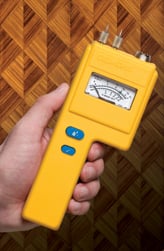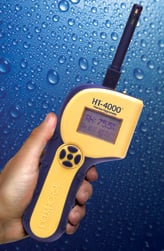 When it comes to manufacturing a piece of wooden furniture or wood floorboards for a new house, there are any number of “secrets” to getting the job done perfectly. Sayings such as “measure twice, cut once” are popular (and often effective) pieces of advice that can really help you make sure that the job is done right.
When it comes to manufacturing a piece of wooden furniture or wood floorboards for a new house, there are any number of “secrets” to getting the job done perfectly. Sayings such as “measure twice, cut once” are popular (and often effective) pieces of advice that can really help you make sure that the job is done right.
But, there is more to ensuring that your wood flooring and furniture is defect-free than just making sure your measurements and cuts are done in a precise and consistent manner. The real secret to making sure that your wooden products will last for a long time and not develop defects is to use a moisture meter.
Moisture Meters and Wood
For years, the best wood products manufacturers have tested their lumber with moisture meters to help ensure that the wood’s moisture content is neither too much nor too little. While less-experienced contractors and furniture makers might simply make the cuts in the wood and call it a day, the true experts distinguish themselves by measuring not only the length of each piece of wood they use, but the moisture content of that wood as well.
 By monitoring the moisture content of the wood that they work with, furniture manufacturers greatly reduce the chances that the chairs, tables, and other pieces of furniture that they make will suffer from defects related to moisture. Careful monitoring of the moisture in wood is key to knowing whether or not that piece of wood can be safely used for any application.
By monitoring the moisture content of the wood that they work with, furniture manufacturers greatly reduce the chances that the chairs, tables, and other pieces of furniture that they make will suffer from defects related to moisture. Careful monitoring of the moisture in wood is key to knowing whether or not that piece of wood can be safely used for any application.
For example, using a pinless moisture meter to scan large, flat pieces of lumber after they finish the acclimation process allows a woodworker to find a hidden pocket of moisture that could cause said lumber to develop problems such as swelling or even delamination.
On the other hand, a pin-type meter can be used to get a more precise reading of exactly how deep in the lumber the moisture pocket is as well as giving the woodworker an idea of how close that piece of lumber is to reaching the appropriate equilibrium moisture content (EMC) for the region the wood will be shipped to after it is turned into a finished product. This way, the woodworker knows if the wood merely needs to acclimate for a few extra days or repurposed for wood chips.
Verifying Wood Acclimation
Speaking of the acclimation process, there is a particular device that every woodworker needs to use during this process: a thermo-hygrometer. Rather than measuring moisture directly in wood, these devices read the temperature and relative humidity conditions in a given space.

When acclimating wood, the area where the wood is being stored has to be kept at a specific temperature and RH range, dependent on where the wood is going to be shipped. As stated by the NWFA, the typical RH range is between 30% and 50% at a temperature between 60° F and 80° F. Failure to properly acclimate the wood can cause problems, but how can a woodworker guarantee that they’re storing the wood in the right conditions?
Smaller woodworking shops might use an HVAC system to regulate the temperature and humidity, while large wood plants use specialized humidification systems to control the RH of their storing and manufacturing facilities. However, it is imperative that the RH of the room is verified with a thermo-hygrometer to make sure that the humidity and temperature control system is actually maintaining the right conditions for the wood.
With a thermo-hygrometer, woodworkers can measure the relative humidity of the space where they are acclimating their lumber and verify that it is in the proper range. While temperature variances can cause the RH reading to change, top-of-the-line thermo-hygrometers with fast response times can easily handle wide ranges of temperatures in any environment.
With a few rugged and reliable moisture meters and thermo-hygrometers, a woodworker can craft with confidence, secure in the knowledge that their wood-based products will not be compromised by excess moisture.
Get Quality, Get Delmhorst
Delmhorst moisture meters come in many varieties to meet your specific needs. Not only that, but all of our moisture meters are backed by our one-year warranty. We also can proudly say that our moisture meters are made in America, and our production is not outsourced. We build our meters to meet or exceed industry standards, and calibrations are traceable to the NIST.
If you need a moisture meter for your next woodworking job, be sure to contact us today. Delmhorst’s moisture meter specialists have years of experience in assisting others with a variety of questions about the products we make. Get the right meter to make sure that your next woodwork item is built to last.

Comments